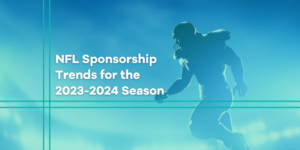
NFL Sponsorship Trends for the 2023-2024 Season
Last week, the 88th annual NFL Draft was held outside of Kansas City’s Union Station, kicking off conversations and excitement around sponsorship trends for the 2023-2024 season. The Chicago Bears originally owned the first pick (their first time since 1947), but traded it to the Carolina Panthers for multiple draft picks and wide receiver DJ Moore. The Panthers selected Alabama quarterback Bryce Young with the first pick and the Los Angeles Rams selected Desjuan Johnson with the final pick. Now that all 32 teams have their rosters in order, advertisers are ready to weigh their options for sponsorship opportunities.
Media trends show that NFL sponsors are exposed to serious crowds:
- The NFL’s regular-season games in 2022 averaged 16.7m viewers per game
- Super Bowl LVII attracted 113m viewers
- NFL games accounted for 82 of the 100 most-watched telecasts in 2022
- The average NFL crowd increased by 3.25% per game in 2022, the second-largest figure in almost two decades
Of course, sports sponsorships have countless benefits for brands. First, there’s significant brand exposure that can help increase recognition, sales, and customer loyalty. Consumers associate their favorite football teams with positive values and set brands up for relationship-building with fans, players, and other sponsors. Here are four NFL sponsorship trends the Winmo team predicts for the 2023-2024 season:
1) Tech will continue to change the landscape
NFL fans have universal access to all games through streaming and apps. These ongoing questions in media rights can present a challenge to sponsors since it’s never clear where fans watch from. Additionally, thanks to the rise of short-form content (looking at you, TikTok), long-form content is starting to disappear from Gen Z social media feeds. Sponsors will not only have to use more tech in campaigns, but also integrate themselves into the sport (like the NFL Apple Music Half-Time Show). In order to better connect with fans, venues must also enhance their sponsorship portfolios with dynamic and digitally intriguing assets that create a lasting impression.
2) New opportunities for alcohol brands
These advertisers have historically been kept at arm’s length from the NFL. Whiskey, vodka, rum, and other spirit brands weren’t allowed to advertise with the NFL until 2018. While some liquor brands partnered with individual teams and have advertised in other major professional sports leagues before, this was still a major milestone. And a wake-up call to beer brands that have historically been unencumbered. Networks and leagues, even popular ones like the NFL, need more revenue opportunities. The NFL can no longer turn away those like liquor brands that feed it ad dollars.
3) New opportunities for gambling brands
Gambling advertisers have grown fond of the NFL, especially given the pandemic-induced boom in sportsbook apps. Casinos and mobile gaming apps recorded a record $54.93b in revenue last year. The NFL is fully aware of the gambling boom, signing deals with DraftKings, FanDuel, and Caesars Entertainment that could be worth roughly $1b in revenue for the league in the next five years.
4) Nontraditional assets will continue to grow
This is good news for both brands and rights holders. While there have typically been a finite number of physical assets for sponsorship executives to sell, sports organizations are now sitting on a vast array of digital inventory that can meet the needs of brands that might be shifting away from more traditional advertising strategies. Both the NFL and FIFA launched their own streaming services over the past year. Those platforms not only allow the leagues to super-serve their fans with large amounts of content, but also gives them strong bargaining positions while they negotiate sponsorship renewals and enter conversations with potential partners.




